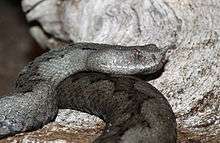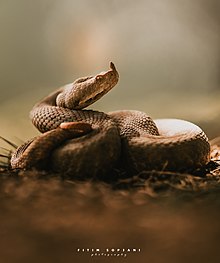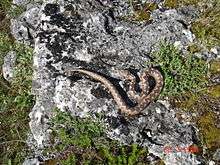Vipera ammodytes
Vipera ammodytes (other common names include horned viper, long-nosed viper, nose-horned viper, sand viper)[3] is a viper species found in southern Europe, mainly the Balkans, and parts of the Middle East. It is reputed to be the most dangerous of the European vipers due to its large size, long fangs (up to 13 mm) and high venom toxicity.[4] The specific name, ammodytes, is derived from the Greek words ammos, meaning "sand", and dutes, meaning "burrower" or "diver", despite its preference for rocky habitats.[5] Five subspecies are currently recognized, including the nominate subspecies described here.[6]
| Vipera ammodytes | |
|---|---|
 | |
| Scientific classification | |
| Kingdom: | Animalia |
| Phylum: | Chordata |
| Class: | Reptilia |
| Order: | Squamata |
| Suborder: | Serpentes |
| Family: | Viperidae |
| Genus: | Vipera |
| Species: | V. ammodytes |
| Binomial name | |
| Vipera ammodytes | |
| Synonyms[2] | |
| |
Description
V. ammodytes grows to a maximum total length (body + tail) of 95 cm (37.5 in), although individuals usually measure less than 85 cm (33.5 in). Maximum length also depends on race, with northern forms distinctly larger than southern ones.[4] The average total length is 50–70 cm (19.5–27.5 in) with reports of specimens over 1 m (39 in) in total length.[7] Females are usually larger and more heavily built, although the largest specimens on record are males.[7]
The head is covered in small, irregular scales that are either smooth or only weakly keeled, except for a pair of large supraocular scales that extend beyond the posterior margin of the eye. 10–13 small scales border the eye, and two rows separate the eye from the supralabials. The nasal scale is large, single (rarely divided), and separated from the rostral by a single nasorostral scale. The rostral scale is wider than it is long.[4]
The most distinctive characteristic is a single "horn" on the snout, just above the rostral scale. It consists of 9–17 scales arranged in 2 (rarely 2 or 4) transverse rows.[4] It grows to a length of about 5 mm (0.20 in) and is actually soft and flexible. In southern subspecies, the horn sits vertically upright, while in V. a. Ammodytes it points diagonally forward.[3]
The body is covered with strongly keeled dorsal scales in 21 or 23 rows (rarely 25) at mid-body. The scales bordering the ventrals are smooth or weakly keeled. Males have 133–161 ventral scales and 27–46 paired subcaudals. Females have 135–164 and 24–38 respectively. The anal scale is single.[4]

The color pattern is different for males and females. In males, the head has irregular dark brown, dark gray, or black markings. A thick, black stripe runs from behind the eye to behind the angle of the jaw. The tongue is usually black, and the iris has a golden or coppery color. Males have a characteristic dark blotch or V marking on the back of the head that often connects to the dorsal zigzag pattern. The ground color for males varies and includes many different shades of gray, sometimes yellowish or pinkish gray, or yellowish brown. The dorsal zigzag is dark gray or black, the edge of which is sometimes darker. A row of indistinct, dark (occasionally yellowish) spots runs along each side, sometimes joined in a wavy band.[4]
Females have a similar color pattern, except that it is less distinct and contrasting. They usually lack the dark blotch or V marking on the back of the head that the males have. Ground color is variable and tends more towards browns and bronzes, such as grayish brown, reddish brown, copper, "dirty cream", or brick red. The dorsal zigzag is a shade of brown.[4]
Both sexes have a zigzag dorsal stripe set against a lighter background. This pattern is often fragmented. The belly color varies and can be grayish, yellowish brown, or pinkish, "heavily clouded" with dark spots. Sometimes the ventral color is black or bluish gray with white flecks and inclusions edged in white. The chin is lighter in color than the belly. Underneath, the tip of the tail may be yellow, orange, orange-red, red, or green. Melanism does occur, but is rare. Juvenile color patterns are about the same as the adults.[4]
Common names
Horned viper, long-nosed viper, nose-horned viper, sand viper,[3] sand adder, common sand adder, common sand viper,[8] sand natter.[9]
Geographic range
Southern Austria, north-eastern Italy, Slovenia, Croatia, Bosnia-Herzegovina, Serbia, Montenegro, Albania, Kosovo, North Macedonia, Greece (including Cyclades), Romania, Bulgaria, Turkey, Georgia and Syria.
.png)
The type locality is listed as "Oriente". Schwarz (1936) proposed that the type locality be restricted to "Zara" (Zadar, Croatia).[2]
Conservation status
This species is listed as strictly protected (Appendix II) under the Berne Convention.[10]
Habitat
The common name sand viper is misleading, as this species does not occur in mostly sandy areas.[11] V. ammodytes primarily inhabits dry, rocky hillsides with sparse vegetation. Not usually associated with woodlands, but if so it will be found there around the edges and in clearings. Sometimes found in areas of human habitation, such as railway embankments, farmland, and especially vineyards if rubble piles and stone walls are present. May be found above 2000 m at lower latitudes.[4]
Behaviour
This species has no particular preference for its daily activity period. At higher altitudes, it is more active during the day. At lower altitudes, it may be found at any time of the day, becoming increasingly nocturnal as daytime temperatures rise.[4]
Despite its reputation, this species is generally lethargic, not at all aggressive, and tends not to bite without considerable provocation. If surprised, wild specimens may react in a number of different ways. Some remain motionless and hiss loudly, some hiss and then flee, while still others will attempt to bite immediately.[4]
Vipera ammodytes hibernates in the winter for a period of 2 to 6 months depending on environmental conditions.[7]

Feeding
Primarily feeds on small mammals and birds. Juveniles apparently prefer lizards. Feeding behavior is influenced by prey size. Larger prey are struck, released, tracked, and swallowed, while smaller prey is swallowed without using the venom apparatus. Occasionally, other snakes are eaten.[4] There are also reports of cannibalism.[7]
Reproduction
Before mating, the males of this species will engage in a combat dance, similar to adders.[4] Mating takes place in the spring (April–May), and one to twenty live young are born in late summer or fall (August–October). At birth, juveniles are 14–24 cm (5.5–9.4 in) in total length.[7] This species is ovoviviparous.[12]
Captivity
This species has often been kept in captivity and bred successfully.[4] It tolerates captivity much better than other European vipers, thriving in most surroundings and usually taking food easily from the start.[12] However, as far as handling is concerned, despite its relatively placid reputation, pinning and necking this snake can be risky, as they are relatively strong and can unexpectedly jerk free from a keeper's grasp. For close examinations, it is therefore advisable to use a clear plastic restraining tube instead.[7]
Venom
This is likely the most dangerous snake to be found in Europe.[13] In some areas it is at least a significant medical risk.
The venom can be quite toxic [based on tests conducted solely on mice], but varies over time and among different populations.[4] Brown (1973) gives an LD50 for mice of 1.2 mg/kg IV, 1.5 mg/kg IP and 2.0 mg/kg SC.[14] Novak et al. (1973) give ranges of 0.44–0.82 mg/kg and IV and 0.19–0.64 mg/kg IP. Minton (1974) states 6.6 mg/kg SC.[4]
The venom has both proteolytic and neurotoxic components and contains hemotoxins with blood coagulant properties, similar to and as powerful as in crotaline venom. Other properties include anticoagulant effects, hemoconcentration and hemorrhage. Bites promote symptoms typical of viperid envenomation, such as pain, swelling and discoloration, all of which may be immediate. There are also reports of dizziness and tingling.[4]
Humans respond rapidly to this venom, as do mice and birds. Lizards are less affected, while amphibians may even survive a bite. European snakes, such as Coronella and Natrix, are possibly immune.[4]
Vipera ammodytes venom is used in the production of antivenin for the bite of other European vipers and the snake is farmed for this purpose.[8][12]
Taxonomy
This species was originally described by Carl Linnaeus in Systema Naturae in 1758. Subsequently, George Albert Boulenger described a number of subspecies in the early 20th century that are still mostly recognized today. However, there are many alternative taxonomies.[4] One additional subspecies that may be encountered in literature is V. a. ruffoi (Bruno, 1968),[4] found in the Alpine region of Italy. However, many consider both V. a. ruffoi and V. a. gregorwalineri to be synonymous with V. a. ammodytes,[7] and consider V. a. transcaucasiana to be a separate species.[4][7]
| Subspecies[6] | Taxon author[6] | Common name | Geographic range |
|---|---|---|---|
| V. a. ammodytes | (Linnaeus, 1758) | Western sand viper[11] | Austria (Styria, Carinthia), north Italy, Slovenia, Croatia, Bosnia-Herzegovina, Serbia, Montenegro, North Macedonia, Albania, south-west Romania, north-west Bulgaria[4] |
| V. a. gregorwallneri | Sochurek, 1974 | Austria, Slovenia, Croatia, Bosnia-Herzegovina, Serbia, Montenegro, North Macedonia[7] | |
| V. a. meridionalis | Boulenger, 1903 | Eastern sand viper[11] | Greece (incl. Corfu and other islands), Turkish Thrace[4] |
| V. a. montandoni | Boulenger, 1904 | Transdanubian sand viper[11] | Bulgaria, south Romania[4] |
| V. a. transcaucasiana | Boulenger, 1913 | Transcaucasian sand viper[4] | Georgia, north Turkish Anatolia[4] |
References
- Aram Agasyan; Aziz Avci; Boris Tuniyev; Jelka Crnobrnja Isailovic; Petros Lymberakis; Claes Andrén; Dan Cogalniceanu; John Wilkinson; Natalia Ananjeva; Nazan Üzüm; et al. (2009). "Vipera ammodytes". The IUCN Red List of Threatened Species. IUCN. 2009: e.T62255A12584303. doi:10.2305/IUCN.UK.2009.RLTS.T62255A12584303.en.
- McDiarmid, R.W., Campbell, J.A., Touré, T. 1999. Snake Species of the World: A Taxonomic and Geographic Reference, Volume 1. Herpetologists' League. 511 pp. ISBN 1-893777-00-6 (series). ISBN 1-893777-01-4 (volume).
- Street, D. 1979. The Reptiles of Northern and Central Europe. London: B.T. Batsford Ltd. 268 pp. ISBN 0-7134-1374-3.
- Mallow, D., Ludwig, D., Nilson, G. 2003. True Vipers: Natural History and Toxinology of Old World Vipers. Malabar, Florida: Krieger Publishing Company. 359 pp. ISBN 0-89464-877-2.
- Gotch, A.F. 1986. Reptiles – Their Latin Names Explained. Poole, UK: Blandford Press. 176 pp. ISBN 0-7137-1704-1.
- "Vipera ammodytes (Linnaeus, 1758)". Integrated Taxonomic Information System. Retrieved 26 July 2006.
- Strugariu, A. 2006. The European Horn-Nosed Viper Archived 14 October 2013 at the Wayback Machine. VenomousReptiles.org.
- Mehrtens, J.M. 1987. Living Snakes of the World in Color. New York: Sterling Publishers. 480 pp. ISBN 0-8069-6460-X.
- U.S. Navy. 1991. Poisonous Snakes of the World. US Govt. New York: Dover Publications Inc. 203 pp. ISBN 0-486-26629-X.
- Convention on the Conservation of European Wildlife and Natural Habitats, Appendix II Archived 16 July 2015 at the Wayback Machine at Council of Europe. Accessed 9 October 2006.
- Steward, J.W. 1971. The Snakes of Europe. Cranbury, New Jersey: Associated University Press (Fairleigh Dickinson University Press). 238 pp. LCCCN 77-163307. ISBN 0-8386-1023-4.
- Stidworthy, J. 1974. Snakes of the World. Grosset & Dunlap Inc. ISBN 0-448-11856-4.
- Arnold, E.N.; Burton, J.A. 1978. A Field Guide to the Reptiles and Amphibians of Britain and Europe. London: Collins. 272 pp. ISBN 0-00-219318-3. (Vipera ammodytes, pp. 222–223 + Plate 40 + Map 125.)
- Brown, J.H. 1973. Toxicology and Pharmacology of Venoms from Poisonous Snakes. Springfield, Illinois: Charles C. Thomas. 184 pp. LCCCN 73–229. ISBN 0-398-02808-7.
Further reading
- Biella, H.-J. 1983. Die Sandotter. Die Neue Brehm-Bücherei. A. Ziemsen Verlag. Wittenberg Lutherstadt. 84 pp.
- Bruno, S. 1968. Sulla Vipera ammodytes in Italia. Memorie del Museo Civico di Storia Naturale, Verona 15: 289–386.
- Copley, A.; Banerjee, S.; Devi, A. 1973. Studies of snake venom on blood coagulation. Part I: The thromboserpentin (thrombin-like) enzyme in the venoms. Thromb. Res. 2: 487–508.
- Gulden, J. 1988. Hibernation and breeding of V. ammodytes ammodytes. Litteratura Serpentium 8: 168–72.
- Hays, W.S.T.; Conant, Sheila. 2007. Biology and Impacts of Pacific Island Invasive Species. 1. A Worldwide Review of Effects of the Small Indian Mongoose, Herpestes javanicus (Carnivora: Herpestidae). Pacific Science 61 (1): 3–16.
- Linnaeus, C. 1758. Systema naturæ per regna tria naturæ, secundum classes, ordines, genera, species, cum characteribus, diferentiis, synonymis, locis. Tomus I. Editio Decima, Reformata. Stockholm: L. Salvius. 824 pp. (Coluber ammodytes, pp. 216–217.)
- Nikolsky, A.M. 1916. Fauna of Russia and adjacent countries. Volume II: Ophidia. Petrograd: Translation from the Israel Program for Scientific Translations, Jerusalem, 1964, 247 pp.
- Meier, J.; Stocker, K.F. 1991. "Snake venom protein C activators". In: Tu, A., editor. Reptile venoms and Toxins. New York: Marcel Dekker. pp. 265–79.
- Mertens, R.; Wermuth, H. 1960. Die Amphibien und Reptilien Europas. Frankfurt am Main: Verlag Waldemar Kramer. 264 pp.
- McMahon, M. 1990. Vipera ammodytes meridonalis envenomation. Journal of the Herpetological Association of Africa 37: 60.
- Petkovic, D.; Javanovic, T.; Micevic, D.; Unkovic-Cvetkovic, N.; Cvetkovic, M. 1979. Action of Vipera ammodytes venom and its fractionation on the isolated rat heart. Toxicon 17: 639–644.
- Schwarz E. 1936. Untersuchungen über Systematik und Verbreitung der europäischen und mediterranen Ottern. In: Die europäischen und mediterranen Ottern und ihre Gifte. Behringwerk-Mitteilungen 7: 159–362.
External links
| Wikimedia Commons has media related to Vipera ammodytes. |
- Vipera ammodytes at the Reptarium.cz Reptile Database. Accessed 21 November 2007 {{{year}}}.
- Vipera ammodytes at Amphibians and Reptiles of Europe. Accessed 7 October 2006.
- Vipera ammodytes – nose-horned viper at Faculty of Biology and Geology, "Babes-Bolyai" University, Romania. Accessed 7 October 2006.
- Vipera ammodytes at Club100. Accessed 7 October 2006.
- Vipera ammodytes at Amphibians & Reptiles in Bulgaria and Balkan Peninsula. Accessed 7 October 2006.
- Vipera ammodytes mating movie at VipersGarden. Accessed 7 October 2006.
- Video footage of three species, incl. V. ammodytes. on YouTube Accessed 4 November 2006.
- Vipera ammodytes giving birth in terrarium. pictures provided by Terrarium Morbidum. Accessed 4 June 2009.
